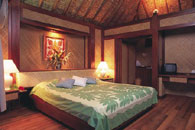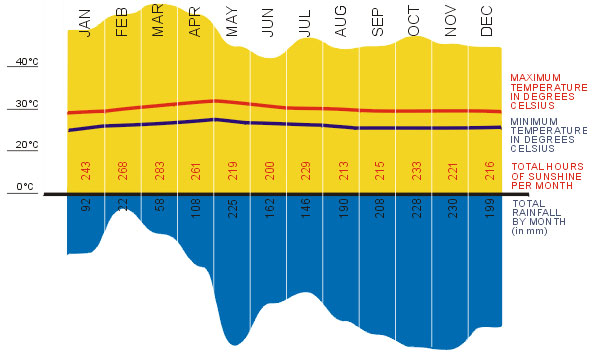|
What
to wear
Dress is generally casual. T-shirts and cotton clothing are most suitable.
In Male’, the capital island and other inhabited islands it is
recommended that women wear modest clothing without baring too much.
Population
About 270,000 according to 1998 estimates. Origin of the Maldivians
are lost in antiquity, but history reveals that the islands have been
populated for over 3,000 years ago. Early settlers were travellers on
the Silk Route and from the Indus Valley Civilisation. Inherently warm,
friendly and hospitable by nature, it is easy to feel comfortable and
relaxed with a Maldivian.
Culture
A proud history and rich culture evolved from the first settlers who
were from various parts of the world travelling the seas in ancient
times. The Maldives has been a melting pot of different cultures as
people from different parts of the world came here and settled down.
Some of the local music and dance for instance resemble African influences,
with handbeating of drums and songs in a language that is not known
to any but certainly represents that of East African countries. As one
would expect there is a great South Asian influence in some of the music
and dancing and especially in the traditional food of the Maldivians.
However many of the South Asian customs especially with regard to women
- for instance the Sub Continent’s tradition of secluding women
from public view - are not tenets of life here. In fact women play a
major role in society - not surprising considering the fact men spend
the whole day out at sea fishing. Many of the traditions are strongly
related to the seas and the fact that life is dependent on the seas
around us.
Language
Dhivehi is the language spoken in all parts of the Maldives. English
is widely spoken by Maldivians and visitors can easily make themselves
understood getting around the capital island. In the resorts, a variety
of languages are spoken by the staff including English, German, French,
Italian and Japanese.
Underwater
Beauty
The Maldives is famed for its rare underwater beauty. The profusion
of psychedelic colours and the abundance and variety of life underwater
have fascinated divers and snorkellers since Maldives was discovered
as a diving destination. The highest level of visibility that one could
expect- sometimes exceeding 50 metres - and warm temperatures throughout
the year makes diving in the Maldives a delight you would want to experience
over and over again. The Maldives has some of the best dive sites in
the world and many visit the Maldives repeatedly for the sole purpose
of diving.
All resorts
in the Maldives have professional dive schools with multi-lingual instructors
and conduct courses for beginners as well as the advanced.
Many of
the resorts have excellent house reefs. Just a short swim from the beach
and snorkellers too can experience the same pleasures from the surface.
Male'
- the capital
Male’ would certainly count as one of the smallest capitals in
the world in terms of its physical size. A third of the country’s
population, about 75,000 live in Male’. Different from any other
island in the country, Male’ is a city of high-rise buildings and
paved roads. While the government offices are located in one area, the
main streets are lined with shops and offices. In the old bazaar area
which still houses the country’s hub of wholesale and retail trade,
the lanes are so narrow that a single vehicle would find it difficult
to navigate through, especially with its throngs of busy people.
There are no beaches on Male’; instead seawalls surround all its
sides. However, a newly landscaped artificial beach area and adjoining
breakwater stretching all the way round to the harbour in the southwest
of the island provide a pleasant jogging route, especially popular in
the evenings when it is cooler.
Male’
is still relatively green and pleasant. The streets in the residential
areas are shaded with trees, at places forming an arch overhead. A fair
number of main streets are lined with big trees providing shade on both
sides. Even a stroll around it would offer interesting sites and shots
for the memories; the fish market and the local market at the northern
waterfront, the new harbour in the south-west corner and the 400-year
old Friday Mosque, to name a few. A stroll around the residential areas
or shopping streets would provide an insight into the life and livelihood
of the residents of the capital. Or simply sit down and relax at one
of the small parks dotted around the capital and just observe the pace
of life.
You may
be surprised at the large number of motorised vehicles in Male’.
If you prefer, you could make a tour of the capital by taxi. Many taxi
centres operate a number of comfortable, well-maintained taxis. The
maximum rates that can be charged are set by the government; the basic
fare for a single journey for four persons or less, from one point to
another is MRf.15.00, luggage carried in the trunk is charged at the
rate of MRf.5.00 per item, the basic charge increases to MRf.20.00,
from 12.00 midnight to 06.00 in the morning and charters cost MRf.85.00
per hour.
Clothing
The Maldives is hot throughout the year. Light, summer cotton and linen
wear is ideal. Pack lots of tee shirts, beachwear, light skirts, cotton
shirts, slacks and shorts. At the resorts where you’ll have to
walk on soft sand most of the time, going barefoot may be ideal for
some. However on visits to inhabited islands, where most of the streets
are of compact sand, or Male’ where most of the streets are paved,
casual shoes or sandals are easy to walk on.
Regulations
and norms
It must be said that official regulations do not allow public nudity
anywhere in the Maldives. Even at the beach on your resort or swimming
or snorkelling around your cruise boat. At least bikinis or swimming
trunks is a must. Most resorts do not allow swimwear inside the restaurants,
to avoid offending fellow holidaymakers. At the in-house bars or restaurants
casual cotton tropical wear is highly recommended.
Visiting
inhabited islands or Male’ the capital requires paying a little
attention to what you wear. Most resorts would advice you on this before
you leave on excursions. Please be sensitive to local norms, culture
and traditions. On such visits it is important to be clad in a decent
garment, which covers one’s body from the shoulders to the knees.
If you envisage attending a formal meeting or making a formal visit,
do bring along light formal wear.
Health
and
Medical Facilities
All resorts have first aid facilities and on some you can get the services
of a resident doctor and facilities for minor treatment. Some have clinics
with separate observation rooms and small pharmacies. The Indira Gandhi
Memorial Hospital (IGMH) and the ADK Hospital are the two major hospitals
in Male’. In addition there are a number of smaller clinics where
you may consult a doctor. In both the IGMH and ADK doctors are on duty
24 hours of the day. Both conduct surgery and offer a number of specialist
services.
Personal
Medical Requirements
If you suffer from a permanent disability or chronic illness it is advisable
to inform your resort before arrival and find out whether they can cater
for your specific requirements. Most resorts cater for special dietary
requirements without additional charges. If you are dependent on any
medications please bring along an ample supply, together with a valid
prescription in case you are required to produce it at Customs.
If you
are planning to take up diving during your visit, it is a good idea
to consult your physician and do a medical check-up to see if you are
fit enough. For safety, when diving it is important to exercise caution;
follow the right procedures, use proper equipment and most important
follow the directives of your instructor or guide. This is important
even if you are an experienced diver. As one would understand instructors
and guides working here are well versed in the subtleties of the local
conditions, be it currents or tides. A decompression chamber is available,
in case of a diving emergency.
Take
care
Be careful where you eat and drink when in the Maldives. Registered
outlets are usually safe. Avoid raw fruits and vegetables from dubious
sources or of unknown nature without consulting someone you can trust.
Drink plenty of water to avoid dehydration. Use sun creams of a high
factor especially during the first few days. A variety of sun creams
and lotions are available in all resort shops and boutiques.
Arriving
in the Maldives Airport
The first thing you’ll notice as soon as you get off the plane
at Male’ International Airport is that the airport is on an island
all by itself. From the air it looks like a giant aircraft carrier,
the runway occupying most of the island. Catch a glimpse if you can.
In fact to build the airport two islands have been connected through
reclamation. However it is a full fledged international airport that
can cater to the largest of aircraft and is well equipped with modern
facilities. Located just over a kilometre away from Male’ the capital,
the airport is connected to the rest of the country by boats and seaplanes.
|






